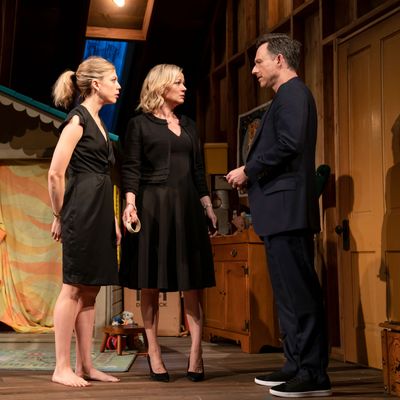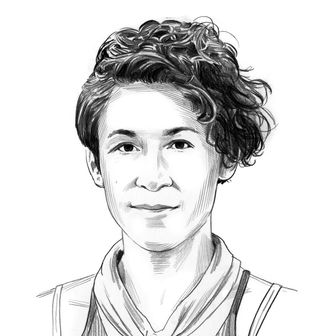
Starting with its title, Bess Wohl’s Make Believe implies a promise of subtle magic that it never really delivers on. Its interests are rich: loss, grief, and the fuzzy line between childhood and adulthood, the way our younger selves and their formative wounds continue to haunt us no matter how old we get. But at least in the current, clunky production directed by Michael Greif at Second Stage, the play never really feels sincerely, effortlessly playful. It ends up thudding where it should tiptoe, stumbling where it should leap. Its contrivances float to the surface, rendering it something that Wohl — author of tight, thoughtful, funny, and gutting plays like Continuity — surely could not have intended: a predictable tearjerker.
We begin with a child — a real child, the sweet-faced Casey Hilton — alone in an attic, playing with a ratty, much-loved Cabbage Patch Kid. David Zinn’s pleasingly cluttered set is stuffed to the brim with nostalgic paraphernalia: a LiteBrite, a Hamburglar doll, one of those quintessential blue plastic Fisher-Price easels. Hilton is Addie Conlee, second youngest of the four Conlee siblings, all of whom, in Make Believe’s first half, appear as kids between the ages of 5 and 12. And there’s the show’s first snag. Whether it’s in the writing or in Greif’s direction (and I suspect it’s a little of Column A, a little of Column B), the Conlee children end up occupying that awkward uncanny valley of kids overacting like kids. In some moments, their behavior seems untruthfully infantile; in other moments, winkingly adult in a way that speaks not of childhood’s weird, real flashes of maturity but of writerliness and forced eccentricity.
Hilton’s buoyant, Twizzlers-loving Addie, who’s supposed to be 7, escapes this trap most often. She’s at that sweet-spot age where performance comes naturally and hasn’t yet been complemented by the useful but potentially crippling sense of self-observation. As her older siblings, Chris and Kate, Ryan Foust and Maren Heary have developed those antennae and overuse them. Heary conscientiously manages to navigate overachiever Kate’s tension and her sparks of drama, but Greif nudges Foust into an especially over-the-top performance as Chris, the older brother who hovers between troubled bully and self-sacrificing savior. It’s not Foust’s fault: He’s young and enthusiastic. But he’s being asked to push rather than allowed to play.
Chris, Kate, and Addie — along with their littlest sibling, Carl (Harrison Fox), who spends most of the play’s first half pretending to be a dog — are left to their own devices one afternoon when their parents mysteriously disappear. Or that’s what the show’s marketing copy tells us. But one of Make Believe’s niggling disappointments is that there’s really no such mystery to be had in the show. Instead of letting the audience exist alongside the Conlee children — in what must be a strange and terrifying period of both liberation and loneliness, like being set adrift on an unknown sea — Wohl keeps us informed of, and weighed down by, the story’s pedestrian reality. We’re never really able to make believe because all too quickly, we know: The kids’ parents are a mess. Dad, a perpetual cheater, goes away on long “business trips” and, this time around, Mom has a breakdown and clears out. All this information, with its drab familiarity, puts us ahead of the kids and ahead of the play, in the comfortable but relatively unengaged position of armchair psychiatrist. Now it’s not really a story of wild, unanswerable questions, but of run-of-the-mill, easily traceable trauma.
And in the second half of the show, when three of the siblings return to the old attic three decades later, that’s exactly what Make Believe becomes. Grown-up Kate (Samantha Mathis), Addie (Susannah Flood), and Carl (Brad Heberlee) are all harried, hurting adults, gathered back together by a not especially surprising tragedy. (A guy named Chris — played with charm and a nicely gauged gradual increase in vulnerability by Kim Fischer — is there too, though he’s not the Chris we know.) Despite the persistent quirkiness of the play’s tone, Wohl doesn’t shy away from formulaic gestures. A funeral brings her characters home again, and the personas of the damaged adult siblings feel rote — especially, when we first meet him, Carl, who shows up late glued to his Bluetooth earpiece like a latter-day Robin Williams in Hook. There are also recurring echoes between the play’s two parts that are meant to move us with layers of meaning and pathos — but adult Kate swilling wine the way her younger self used to pretend to in imitation of her mother, the children running through the space in sheets like ghosts, and the fact that adult Carl ends up howling in grief in the exact same spot on the stage where we watched little Carl howl like a dog … are just a little too obvious to hit us where we live.
Heberlee, though, deserves credit for committing entirely to that howl. He can’t repair the play’s structural overtidiness, but he can throw himself fearlessly into its emotional climax, and he does. His exploration of something weird and ugly and released has teeth and breath in it. This, you think as he begins to come apart, is what Wohl really wants to show us. “Grown-ups aren’t real anyway,” young Addie muses earlier in the play. “They’re only monsters with masks on.” For a line like that to earn its keep, we’ve eventually got to see the monster, the wounded animal, and Heberlee comes close to showing us. In a play that never quite finds its fluidity or its force, that falls victim to the cute and the trite, he gives us a peak behind the curtain at something bigger, more fearsome and more fascinating.
Make Believe is at Second Stage Theater through September 15.





